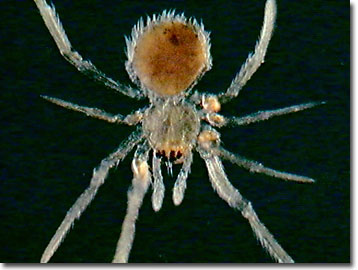Darkfield Digital Image Gallery
Spider
Scaring Miss Muffet and climbing down waterspouts, spiders have been busy interacting with humans, even in nursery rhymes. Representatives of the class Arachnida, spiders are found worldwide with about 35,000 known species (4,000 in North America), but less than one percent are dangerous to humans. Even with such impressive numbers, it is estimated that only 20 percent of the spiders of Australia are scientifically catalogued and some arachnologists estimate there may be as many as 170,000 undescribed species worldwide. As insectivores, spiders are valuable to farmers, feeding regularly on agricultural pests.

View a second image of spiders.
Arachnophobia, or fear of spiders, runs deep with many people and may be justified based on some species. Brown recluse spiders, as the name implies, tend to hide in dark and secluded places such as deep in a closet, at the bottoms of undisturbed boxes of paper, or in attic corners. When a brown recluse is encountered accidentally by an unprotected hand or foot, a venomous bite results in a painful injury that can eventually become necrotic or gangrenous. Infamous, the black widow possesses a venomous bite, but the female's threat to adult humans is largely exaggerated because it rarely injects significant volumes of venom. The goliath bird eater, a very large tarantula species from the rainforests of South America, is capable of capturing birds or bats in its web and consuming them as prey with its one-inch long fangs. An adult bird eater can exceed a quarter of a pound in weight and boast an 11-inch leg span.
Unlike their arthropod cousins the insects, a spider's body is broken into two main body parts, the prosoma (or cephalothorax) and the opisthosoma (or abdomen). Spiders also feature eight, rather than six, segmented legs. The spider's jaws (or chelicerae) are used alternately as fangs, hands, or pliers. Although most spider species are equipped with eight eyes, they still do not see very well. An exception, the jumping spider, can pick out its preferred prey from eight inches away. The number and arrangement of spider eyes is species specific.
Most spider species feature six spinnerets at the posterior tip of their opisthosoma. The spinnerets contain silk glands that secrete liquid silk that is drawn out by the spinnerets in solid strands for constructing feeding webs, cocoons, and threads used for suspension and locomotion. Spider silk is one of the strongest fibers known and researchers are synthesizing variations to explore new applications such as more effective bulletproof vests.
Contributing Authors
Cynthia D. Kelly, Thomas J. Fellers and Michael W. Davidson - National High Magnetic Field Laboratory, 1800 East Paul Dirac Dr., The Florida State University, Tallahassee, Florida, 32310.
BACK TO THE DARKFIELD IMAGE GALLERY
BACK TO THE DIGITAL IMAGE GALLERIES
Questions or comments? Send us an email.
© 1995-2025 by Michael W. Davidson and The Florida State University. All Rights Reserved. No images, graphics, software, scripts, or applets may be reproduced or used in any manner without permission from the copyright holders. Use of this website means you agree to all of the Legal Terms and Conditions set forth by the owners.
This website is maintained by our
Graphics & Web Programming Team
in collaboration with Optical Microscopy at the
National High Magnetic Field Laboratory.
Last Modification Friday, Nov 13, 2015 at 01:19 PM
Access Count Since September 17, 2002: 14346
Visit the website of our partner in introductory microscopy education:
|
|
